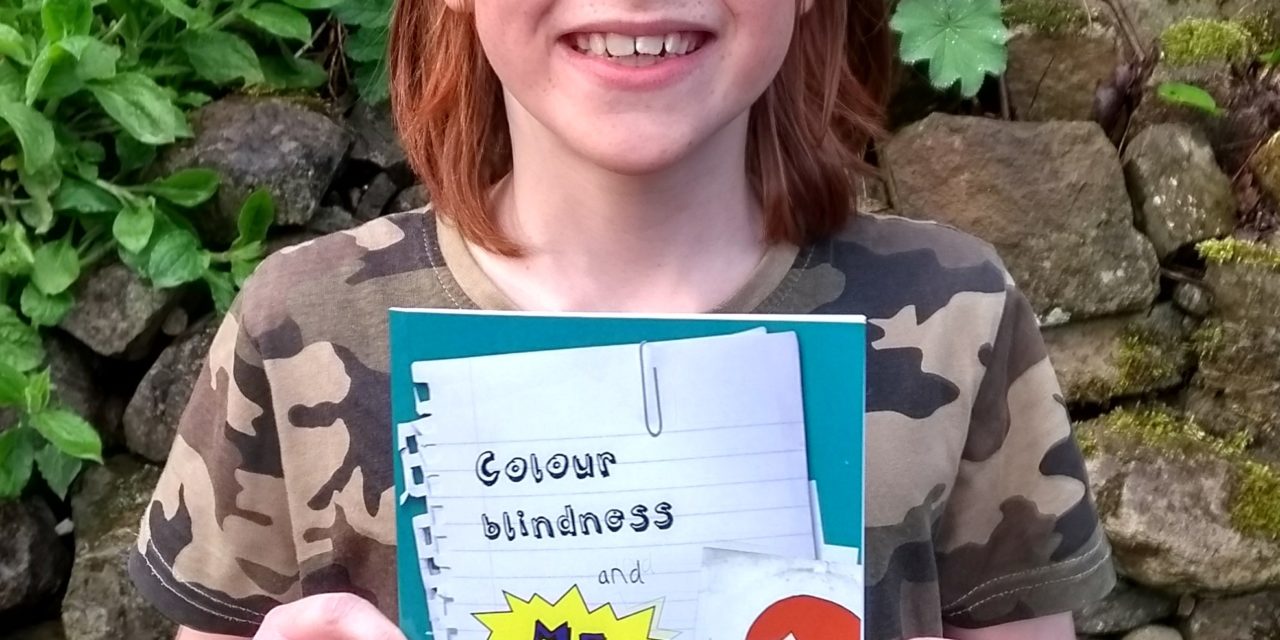By Malachi Sawyer (aged 9 and ¾)
Book Review by Anita Atkinson
This little book is an absolute masterpiece, explaining, as it does, what it is like to be colour blind.
Writing from the heart, young Malachi, who lives in Stanhope and attends Stanhope Barrington School, tells it like it is but also explains the whys and wherefores of the condition in child-speak. He also designed the book himself, including the illustration of himself on the front cover.
I used two of my granddaughters as guinea pigs when I read the book to them at bed-time and they were fascinated, listening intently to every one of Malachi’s words. He very thoughtfully explained on the first page how to pronounce his name and introduced himself very well. He also explained the reason why he is colour blind, simplifying the science behind it and telling readers that his late grandfather had the same condition and that his mother is a carrier. It IS genetic and although there is more to it than that, even I was amazed to discover that one in 12 males are colour blind – far, far more than females where the condition is one in 200. It’s all down to the chromosomes, explains Malachi.
Reading Malachi’s book to my granddaughters led them to having a little discussion afterwards about it. They had heard about colour blindness but neither of them, however, had ever thought about how it may affect someone.
The book is quite entertaining, amusing in parts but also pulls at the heart-strings when Malachi hints at some of the problems he encounters in the big, wide world. He gives a list of things he would rather others didn’t ask him – like questioning him about what colour something is! He maturely accepts that others are ‘only being curious’ even if it is frustrating at times.
He explains how the world looks to him and some of the consequences, including eating unripe bananas and strawberries because the colours that allow most of us to see that these fruits are ripe, are not available to Malachi. Green and red strawberries look the same to him. The book also gives some tips to others like himself and also states that colour blindness can’t be cured. He accepts this fact apparently matter-of-factly.
‘It’s just something you live with,” he writes. And he doesn’t think about it too much until he has to – when he is colouring in, for instance.
Something else he lives with like lots of other children like him, is that he has learned from a young age that there will be some careers that are not open to him in the future. He can’t be an electrician, of course, because he can’t determine the colours of the wires. Nor can he be a pilot, which was one of his ambitions when he was younger. This is something that Malachi seems to have come to terms with, though the psychological implications of things can be heard elsewhere in his book, when he refers to feeling ‘shy’, ‘left out’ or ‘confused’ when colours are used in different situations.
He writes about simple strategies that can be used in schools for children like himself, including simple labelling of pencils with their colours. And he very bravely – and cleverly – explains how he sees the world differently to others to underline his point. He appeals to teachers and sports clubs to think carefully about their use of colour in teaching and the colours of sporting bibs so he can immediately see who is on his team. Perhaps something that others had not thought about before – and his list of ‘things that people can do to make things easier’ is straightforward and simple.
I have learnt, from talking to the family, that the youngster has older sisters who have a colour-blind app on their phones. They use it sometimes to look at the world as Malachi sees it, to remind themselves of his difficulties. His eldest sister, Rebekah, who is a wizard with the Rubik’s cube, was trying to solve the puzzle recently whilst looking through the camera app to see if she could do it with ‘Malachi’s eyes’. She became very frustrated not knowing which colour was which.
The book has been well-received by professionals, including by Sarah Martin-Denham from Wolsingham, a lecturer at Sunderland University, who is the co-author of the SENCO handbook (Special Educational Needs Co-ordinator). In a Twitter broadcast where she was in conversation with Kathryn Albany-Ward, Sarah mentioned Malachi’s book. Kathryn is the founder of www.colourblindawareness.org. She lobbies for changes in education, sport etc. to meet the needs of colour blind people and Malachi points people to her website in his book, to find out more information about colour blindness.
Sarah Martin-Denham said, “Malachi’s book is beautifully written and is an insightful read for both children and adults. The book helpfully shares easy to provide strategies to support colour blind children in accessing and participating in learning and teaching. Thank you, Malachi!”
Staff at Malachi’s school in Stanhope have been very supportive and have encouraged him in his writing. Head Teacher, Deb Cross, said, “
“Everyone at Stanhope Barrington is incredibly proud of Malachi. He is an inspiring young man who has written this inspiring and informative book about Colour Blindness.
“Malachi has shown great courage, determination and resilience both in writing this book and in sharing his personal experiences.
“Both adults and children in school have learnt a lot from Malachi and we are super proud that he is part of our Stanhope Barrington family.”
Colour Blindness and Me by Malachi Sawyer is available for pre-order from Waterstones priced £4.99.










